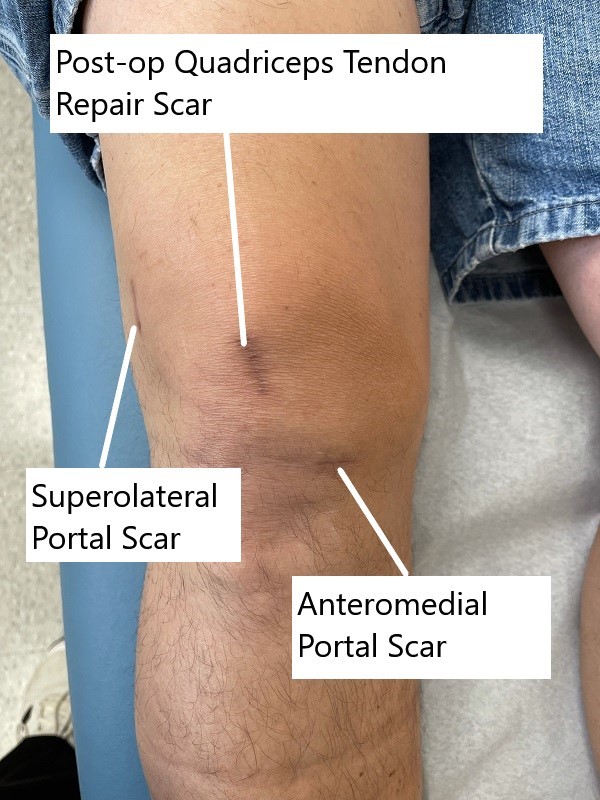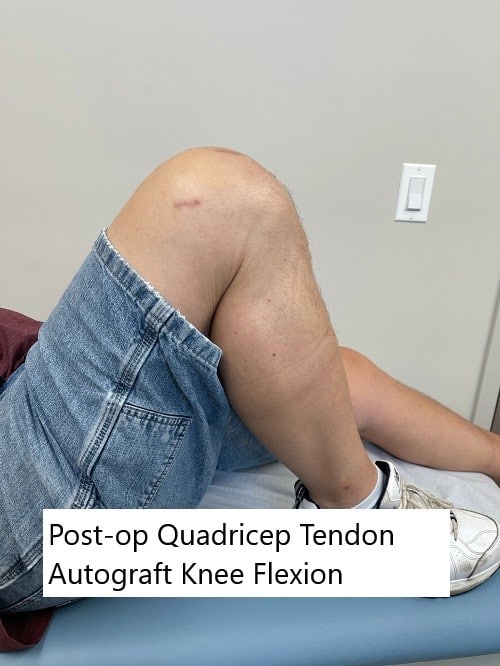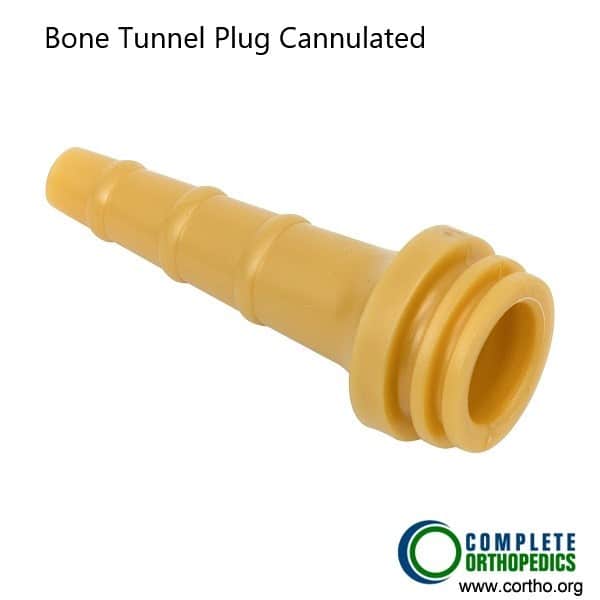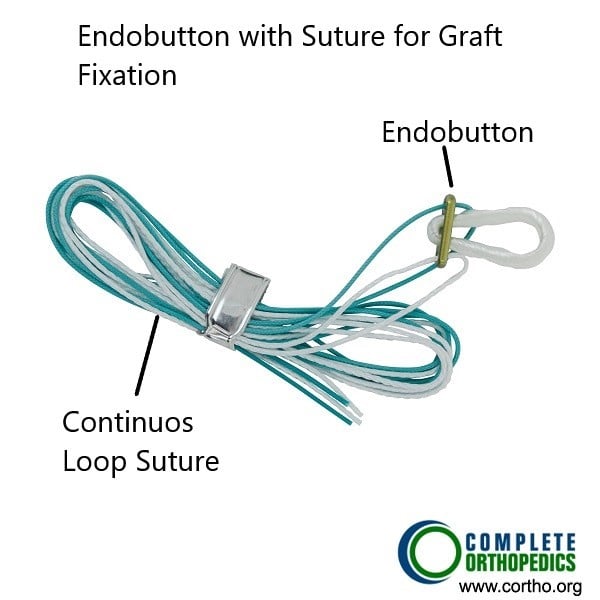ACL Surgery – Allograft vs Autograft
The anterior cruciate ligament reconstruction surgery involves the use of an arthroscope to reconstruct the torn anterior cruciate ligament with graft tissue. Anterior cruciate ligament (ACL) reconstruction is one of the most common orthopedic surgeries. The graft material may either be harvested from the patient’s own body which is known as autograft or from a cadaver known as an allograft.
First things first, let’s break down what these terms mean:
ACL Surgery: This is a surgical procedure done to repair a torn anterior cruciate ligament, one of the key ligaments in your knee.
Allograft: In this type of surgery, the surgeon replaces your torn ACL with a tendon graft from a donor. Yes, you read that right — from a donor!
Autograft: In contrast, an autograft involves taking tissue from your own body, usually from your hamstring tendon or patellar tendon, to reconstruct the ACL.

Postoperative images showing quadriceps tendon autograft scar and range of motion.

Postoperative images showing quadriceps tendon autograft scar and range of motion.
Postoperative images showing quadriceps tendon autograft scar and range of motion.
The choice of graft material depends upon the patient’s age, level of activity, availability, and the operating surgeon’s expertise. Both types of graft are highly successful and have been in use for the past many years. There are pros and cons associated with each type of graft. The patient is educated regarding the type of graft to be used for their surgery.
Autograft ACL reconstruction
Autograft is harvested from the patient’s own body. The graft is a part of the patient’s body that has the same cellular and tissue makeup. Genetic compatibility ensures that the graft is not rejected by the body’s immune system.
Graft harvestation is the first step in autograft ACL reconstruction. The graft is commonly taken from the patellar tendon along with bone blocks from the patella and the tibia (Bone-Patellar-Tendon-Bone). The BPTB graft along with the bony ends helps in the biological incorporation of the graft. The bone ends naturally fuse with the femur and the tibia as they heal.
A hamstring graft is a soft tissue graft harvested utilizing the tendon of hamstring muscle on the inner aspect of the knee. The tendons are quadrupled to increase their strength. The quadrupled tendon has more strength than the natural ACL.
Other autografts that may be used for ACL reconstruction include the quadriceps tendon and the peroneal tendon. The soft tissue tendon grafts are usually secured in the tunnel for ACL using undo buttons, screws, etc.
While the autograft offers the advantage of being a part of the patient’s own body, it may have a few associated cons. The location of the graft site may not help and cause morbidity. Patellar tendon grafts have been associated with pain located in front of the knee. Similarly, hamstring autograft may cause inhibition of the hamstrings. The hamstrings are required to bend the knee and a tendon graft from the hamstring may cause knee weakness. Similar weakness in straightening the knee may result from quadriceps tendon graft.
Autografts:
Lower Risk of Rejection: Since autografts use tissue from your own body, there’s no risk of rejection by your immune system. Your body recognizes its own tissue and is less likely to mount an immune response against it.
Better Healing: Some studies suggest that autografts may provide better long-term stability and healing compared to allografts. Your own tissue might adapt more naturally to its new role in supporting your knee.
Reduced Risk of Disease Transmission: While rare, there’s always a slight risk of disease transmission with allografts since they come from a donor. Autografts eliminate this risk entirely.
Potential for Better Performance: Some athletes prefer autografts because they believe using their own tissue can lead to better performance on the field or court. It’s a psychological boost knowing that it’s your own body’s strength supporting you.

Bone tunnel plug used in ACL reconstruction.
Autograft harvesting also increases the operative time of the surgery. The autograft at times may not be of the required thickness and length to substitute the natural ACL. The autograft ACL reconstruction may also prolong the rehabilitation period.
Allograft ACL reconstruction
Allograft anterior cruciate ligament reconstruction involves the use of a graft harvested from a human cadaver. Allograft may be from a cadaveric achilles tendon, tibialis anterior/posterior tendon, hamstrings or patellar tendon.
The allograft is usually irradiated to kill any infectious agent such as bacteria/viruses. The allograft is readily available and comes in different sizes. The allograft shortened the operative time. The allograft also leads to early incorporation in the bone tunnel. Allograft ACL reconstruction also offers the benefit of no graft site morbidity. Participation in rehabilitation and general recovery is faster than autograft.
Allografts:
Less Painful: Since allograft surgery doesn’t involve harvesting tissue from your own body, you might experience less pain at the donor site. That means less discomfort during your recovery.
Quicker Recovery: Some studies suggest that patients who undergo allograft surgery may have a faster recovery time compared to those who opt for autografts. This could mean getting back to your normal activities sooner.
No Extra Incisions: With allografts, there’s no need for additional incisions to harvest tissue from your own body, which means fewer scars and potentially fewer complications.
Availability: Allografts are readily available, which means you don’t have to wait for your own tissue to heal before scheduling surgery.

Endobutton used to secure the ACL graft.
Allografts however may present a challenge in younger age groups. Allografts in patients aged 30 or less have been associated with early graft failure. The failure may result from the rejection of the cadaveric graft tissue. The body’s immune system may reject the graft and the resulting inflammation may lead to graft failure.
The allograft ACL reconstruction is also considered to be less strong than the autograft reconstruction. The irradiation of the cadaveric graft to kill any infectious agent may also lead to biochemical changes in the structure of the graft that may weaken the integrity of the reconstruction. Although the irradiation kills any infectious agent, there might still be a possibility of transmission of a disease agent.
So, Which One Should You Choose?
Ultimately, the decision between allograft and autograft surgery depends on various factors, including your lifestyle, activity level, and personal preferences. Here are some questions to consider:
How important is a fast recovery to you? If you want to get back to your normal activities as quickly as possible, an allograft might be the way to go.
Are you concerned about the risk of rejection or disease transmission? If so, an autograft might offer peace of mind, knowing that you’re using your own tissue.
Do you prioritize long-term stability and performance? Some evidence suggests that autografts may provide better long-term outcomes, particularly for athletes or individuals with high activity levels.
Are you willing to undergo additional discomfort for the potential benefits of an autograft? Harvesting tissue for an autograft involves an additional surgical site and may result in some discomfort during recovery.
In the end, it’s essential to have a thorough discussion with your orthopedic surgeon to weigh the pros and cons of each option and determine which approach is best for you. Remember, everyone’s situation is unique, so what works for one person may not be the best choice for another.
Summary
ACL surgery is a common procedure that can help restore stability and function to your knee after an injury. Whether you choose an allograft or autograft depends on various factors, including your recovery goals, concerns about rejection or disease transmission, and long-term stability and performance.
Both options have their pros and cons, so it’s crucial to carefully consider your priorities and discuss them with your surgeon. Ultimately, the goal is to choose the approach that offers the best chance for a successful outcome and a return to the activities you love. So, whether you opt for an allograft or an autograft, know that you’re taking an important step towards getting back on your feet and back to doing what you love.
Do you have more questions?
Is ACL surgery the only treatment option for a torn ACL?
While ACL surgery is a common treatment for a torn ACL, nonsurgical options such as physical therapy and bracing may be appropriate for some individuals, particularly those with minor injuries or who are not good candidates for surgery.
How do I know if I need ACL surgery?
The decision to undergo ACL surgery depends on various factors, including the severity of the injury, your symptoms, activity level, and overall health. Your orthopedic surgeon will evaluate your individual situation and recommend the most appropriate treatment option.
What are the different types of ACL surgery available?
There are several different surgical techniques for ACL reconstruction, including using autografts or allografts, as well as various fixation methods. Your surgeon will determine the most suitable approach based on your specific needs and circumstances.
What factors should I consider when choosing between an autograft and an allograft for ACL surgery?
Factors to consider when choosing between an autograft and an allograft for ACL surgery include recovery time, risk of complications, long-term outcomes, and personal preferences. Your surgeon can provide guidance based on your individual situation.
What type of anesthesia is used for ACL surgery?
ACL surgery is commonly performed under general anesthesia, which means you will be asleep and feel no pain during the procedure. In some cases, regional or local anesthesia may be used in addition to or instead of general anesthesia.
How soon after ACL surgery can I start walking?
You may be able to bear weight on your operated leg and start walking with crutches or a brace immediately after ACL surgery, depending on your surgeon’s instructions and the specific technique used.
How long will it take for me to regain full strength in my knee after ACL surgery?
Regaining full strength in your knee after ACL surgery can take several months of dedicated rehabilitation and exercise. Your physical therapist will work with you to gradually increase strength and function in your knee over time
Will I be able to kneel after ACL surgery?
Whether or not you’ll be able to kneel after ACL surgery depends on factors such as the specific technique used, your individual recovery, and any additional procedures that may have been performed. Your surgeon can provide guidance on when it’s safe to resume kneeling activities.
How can I prevent re-injury after ACL surgery?
Preventing re-injury after ACL surgery involves following your surgeon’s recommendations for rehabilitation, gradually returning to activities, and using proper techniques and protective equipment during sports and other physical activities.
What should I expect during the recovery process after ACL surgery?
The recovery process after ACL surgery typically involves a combination of rest, rehabilitation exercises, physical therapy, and gradual return to activities. Your surgeon will provide specific instructions and guidelines to help you navigate the recovery process successfully.
Can ACL surgery be performed on both knees at the same time?
While it is possible to perform ACL surgery on both knees at the same time, this approach may not be suitable for everyone. Your surgeon will evaluate your individual situation and recommend the most appropriate course of action.
Will I need to wear a compression sleeve after ACL surgery?
Whether or not you’ll need to wear a compression sleeve after ACL surgery depends on your surgeon’s recommendations and the specifics of your procedure. Some patients may benefit from wearing a compression sleeve to reduce swelling and provide support during the initial stages of recovery.
What are the potential complications of ACL surgery?
Complications of ACL surgery can include infection, blood clots, stiffness, nerve damage, and graft failure. However, serious complications are rare, especially when surgery is performed by an experienced surgeon and appropriate postoperative care is provided.
How can I prepare my home for recovery after ACL surgery?
Preparing your home for recovery after ACL surgery may involve making modifications such as clearing pathways, arranging furniture to minimize obstacles, and setting up a comfortable recovery area with pillows, blankets, and other essentials.
Will I need to undergo any tests before ACL surgery?
Before ACL surgery, you may undergo preoperative testing such as blood tests, imaging studies (such as X-rays or MRI scans), and a physical examination to assess your overall health and identify any potential risk factors or complications.
How long does ACL reconstruction surgery typically take?
ACL reconstruction surgery usually takes around 1 to 2 hours, depending on the complexity of the injury and the technique used.
Will I need to stay overnight in the hospital after ACL reconstruction surgery?
In most cases, ACL reconstruction surgery is performed on an outpatient basis, meaning you can go home the same day. However, some individuals may require overnight observation, particularly if there are concerns about pain management or other medical issues.
When can I expect to return to sports or physical activities after ACL reconstruction surgery?
The timeline for returning to sports or physical activities varies depending on factors such as the type of graft used, the extent of the injury, and your progress in rehabilitation. In general, most individuals can expect to return to sports within 6 to 12 months after surgery.
Will I be able to fully bend and straighten my knee after ACL reconstruction surgery?
Yes, restoring full range of motion in the knee is an essential goal of ACL reconstruction surgery. Physical therapy will focus on gradually increasing flexibility and strength in the knee joint.
Will I need to wear a knee brace after ACL reconstruction surgery?
Whether or not you need to wear a knee brace after ACL reconstruction surgery depends on factors such as the type of graft used, the extent of the injury, and your surgeon’s recommendations. In some cases, a knee brace may be recommended during sports or strenuous activities to provide additional support and stability.
Will I be able to drive after ACL reconstruction surgery?
You may be able to drive after ACL reconstruction surgery once you are no longer taking pain medications that impair your ability to drive safely and your knee is stable enough to operate the pedals without discomfort. It’s important to follow your surgeon’s guidance regarding driving restrictions.
How can I manage pain and discomfort after ACL reconstruction surgery?
Pain and discomfort after ACL reconstruction surgery can be managed with medications prescribed by your surgeon, such as nonsteroidal anti-inflammatory drugs (NSAIDs) or opioids. Additionally, applying ice to the knee and elevating it can help reduce swelling and discomfort.
Can ACL reconstruction surgery be performed if I have other medical conditions?
ACL reconstruction surgery can often be performed safely in individuals with other medical conditions, but it’s important to inform your surgeon about any preexisting health conditions or medications you’re taking. Your surgeon will assess the risks and benefits of surgery based on your overall health status.

Dr. Suhirad Khokhar
My name is Dr. Suhirad Khokhar, and am an orthopaedic surgeon. I completed my MBBS (Bachelor of Medicine & Bachelor of Surgery) at Govt. Medical College, Patiala, India.
I specialize in musculoskeletal disorders and their management, and have personally approved of and written this content.
My profile page has all of my educational information, work experience, and all the pages on this site that I've contributed to.
